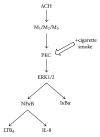Muscarinic receptors and their antagonists in COPD: anti-inflammatory and antiremodeling effects
- PMID: 23226927
- PMCID: PMC3512336
- DOI: 10.1155/2012/409580
Muscarinic receptors and their antagonists in COPD: anti-inflammatory and antiremodeling effects
Abstract
Muscarinic receptors are expressed by most cell types and mediate cellular signaling of their natural ligand acetylcholine. Thereby, they control numerous central and peripheral physiological organ responses to neuronal activity. In the human lung, muscarinic receptors are predominantly expressed by smooth muscle cells, epithelial cells, and fibroblasts. Antimuscarinic agents are used for the treatment of chronic obstructive pulmonary disease and to a lesser extent for asthma. They are primarily used as bronchodilators, but it is now accepted that they are also associated with anti-inflammatory, antiproliferative, and antiremodeling effects. Remodeling of the small airways is a major pathology in COPD and impairs lung function through changes of the extracellular matrix. Glycosaminoglycans, particularly hyaluronic acid, and matrix metalloproteases are among extracellular matrix molecules that have been associated with tissue inflammation and remodeling in lung diseases, including chronic obstructive pulmonary disease and asthma. Since muscarinic receptors have been shown to influence the homeostasis of glycosaminoglycans and matrix metalloproteases, these molecules may be proved valuable endpoint targets in clinical studies for the pharmacological exploitation of the anti-inflammatory and antiremodeling effects of muscarinic inhibitors in the treatment of chronic obstructive pulmonary disease and asthma.
Figures



References
-
- Wickman K, Krapivinsky G, Corey S, et al. Structure, G protein activation, and functional relevance of the cardiac G protein-gated K+ channel, I(KACh) Annals of the New York Academy of Sciences. 1999;868:386–398. - PubMed
-
- Eglen RM. Muscarinic receptor subtypes in neuronal and non-neuronal cholinergic function. Autonomic and Autacoid Pharmacology. 2006;26(3):219–233. - PubMed
-
- Felder CC. Muscarinic acetylcholine receptors: signal transduction through multiple effectors. FASEB Journal. 1995;9(8):619–625. - PubMed
-
- Caulfield MP, Birdsall NJM. International union of pharmacology. XVII. Classification of muscarinic acetylcholine receptors. Pharmacological Reviews. 1998;50(2):279–290. - PubMed
Publication types
MeSH terms
Substances
LinkOut - more resources
Full Text Sources

